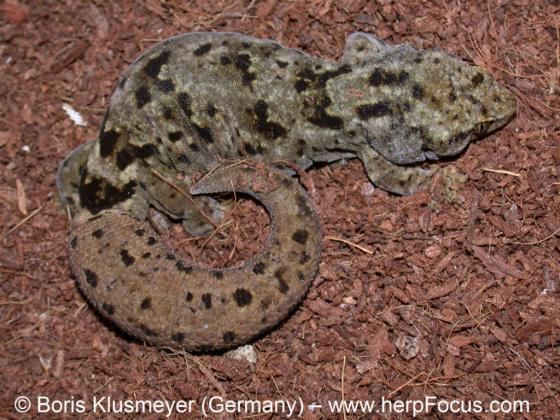Kingdom Animalia Class Reptilia Family Diplodactylidae Scientific name Hoplodactylus maculatus | Phylum Chordata Order Squamata Genus Woodworthia Rank Species | |
 | ||
Similar Woodworthia, Hoplodactylus, Duvaucel's gecko, Oligosoma, Hoplodactylus pacificus | ||
Woodworthia maculatus, the New Zealand common gecko, is a species in the family Diplodactylidae. The specific name maculatus means "speckled".
Contents
Conservation status
As of 2012 the Department of Conservation (DOC) classified the common gecko as Not Threatened under the New Zealand Threat Classification System.
Identification
W. maculatus is a small to medium-sized gecko, with an average length of 155mm and has a predominant colour of grey or brown. The name maculatus refers to the speckled pattern seen on this species (NZ Herpetological Society). The eyes are a greenish brown, with the snout-to-eye distance slightly longer, or equal to, the eye-to-ear distance. Maculatus mouth is lined in pink and has a pink tongue with a grey tip. Woodworthia maculatus often occupies the same area as a couple of similar looking geckos; Dactylocnemis pacificus and W. chrysosireticus. W. maculatus can be distinguished from W. chrysosireticus by the lack of black speckles which are seen on W. chrysosireticus. W. maculatus differs from D. pacificus when looking closely at the nostril. In maculatus the nostril scale is not in contact with the nostril, but in D. pacificus it is in contact.
Range
W. maculatus can be found all over New Zealand; however, individuals in different locations across the country (especially in the North Island) differ from each other in a number of ways. Individuals in the South Island are often more slender and darker in colour than those in the North Island. The species is not usually detected on Stewart Island. In the Hauraki Gulf, the geckos are commonly found on stony beaches and are a smaller size, with crenulated longitudinal stripes. W. maculatus are found in the Coromandel and central North Island are generally found in lowland forests and are much larger, as well as being of various colours. The Southern North Island populations appear to be two-thirds smaller than nearby populations and exhibit sexual dimorphism. Populations which occupy the Cook Strait and nearby mainland’s show to be a mix of the common Northern and Southern forms
Life Cycle/Phenology
W. maculatus has been found to have a characteristically long lifespan, with a suggested lifespan of 20 years by Anastasiadis and Whitaker (1987). However, there were individuals included in a study by Bannock and colleagues that have been aged at 29 years or more. However, more recently Bauer (2013) proposes that the species may live up to 37 years in the wild. Bannock and colleagues suggest that W. maculatus may have a long lifespan to balance their slow reproductive rate. Cree (1994)
Diet/Prey/Predators
Geckos have a simple diet of live insects and smaller organisms. The diet of a gecko includes, but is not limited to, spiders, isopodas, moths, flies, grasshoppers and caterpillars. As expected, due to an individual’s size and preference, the diet has a lot of variation. In other gecko species, the tail acts as a storage organ which can hold reserves of fat which the individual can use in times of food scarcity. Most gecko species cannot digest leaves and other tough plant material easily however, W. maculatus and other New Zealand gecko species feed off plant material that is easily digestible and high in energy like pollen, nectar, sap or fruit .
Mainland geckos are commonly preyed on invasive species such as stoats, cats, hedgehogs and rodents. On off-shore islands where these invasive species are present, the morepork is considered the main predator. Rodents eat both the adult gecko and their eggs and are particularly dangerous for larger geckos. Although W. maculatus are too small to fight them off, their heads are too big to fit in gaps small enough in which they would be safe from the predator. Cree found that W. maculatus reproduces annually, and has evidence to suggest that some populations may be reproducing biannually. Cree also recognised that on average, each female produces less than 2 offspring per year and are slow to mature.
